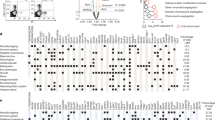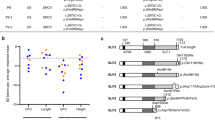Abstract
Gadd45a-null mice generated by gene targeting exhibited several of the phenotypes characteristic of p53-deficient mice, including genomic instability, increased radiation carcinogenesis and a low frequency of exencephaly. Genomic instability was exemplified by aneuploidy, chromosome aberrations, gene amplification and centrosome amplification, and was accompanied by abnormalities in mitosis, cytokinesis and growth control. Unequal segregation of chromosomes due to multiple spindle poles during mitosis occurred in several Gadd45a–/– cell lineages and may contribute to the aneuploidy. Our results indicate that Gadd45a is one component of the p53 pathway that contributes to the maintenance of genomic stability.
This is a preview of subscription content, access via your institution
Access options
Subscribe to this journal
Receive 12 print issues and online access
$209.00 per year
only $17.42 per issue
Buy this article
- Purchase on Springer Link
- Instant access to full article PDF
Prices may be subject to local taxes which are calculated during checkout







Similar content being viewed by others
References
Kastan, M.B. et al. A mammalian cell cycle checkpoint utilizing p53 and GADD45 is defective in ataxia telangiectasia. Cell 71 , 587–597 (1992).
Zhan, Q., Chen, I.T., Antinore, M.J. & Fornace, A.J. Jr Tumor suppressor p53 can participate in transcriptional induction of the GADD45 promoter in the absence of direct DNA binding. Mol. Cell. Biol. 18, 2768–2778 (1998).
Amundson, S.A., Myers, T.G. & Fornace, A.J. Jr Roles for p53 in growth arrest and apoptosis: putting on the brakes after genotoxic stress. Oncogene 17, 3287–3300 ( 1998).
Harkin, D.P. et al. Induction of GADD45 and JNK/SAPK-dependent apoptosis following inducible expression of BRCA1. Cell 97, 575–586 (1999).
Donehower, L.A. et al. Mice deficient for p53 are developmentally normal but susceptible to spontaneous tumours. Nature 356, 215–221 (1992).
Sah, V.P. et al. A subset of p53-deficient embryos exhibit exencephaly. Nature Genet. 10, 175–180 (1995).
Ko, L.J. & Prives, C. p53: puzzle and paradigm. Genes Dev. 10, 1054–1072 (1996).
Deng, C., Zhang, P., Harper, J.W., Elledge, S.J. & Leder, P. Mice lacking p21CIP1/WAF1 undergo normal development, but are defective in G1 checkpoint control. Cell 82, 675–684 (1995).
Brugarolas, J. et al. Radiation-induced cell cycle arrest compromised by p21 deficiency. Nature 377, 552–557 (1995).
Smith, M.L. et al. Interaction of the p53-regulated protein Gadd45 with proliferating cell nuclear antigen. Science 266, 1376– 1380 (1994).
Kearsey, J.M., Coates, P.J., Prescott, A.R., Warbrick, E. & Hall, P.A. Gadd45 is a nuclear cell cycle regulated protein which interacts with p21Cip1. Oncogene 11, 1675–1683 (1995).
Takekawa, M. & Saito, H. A family of stress-inducible GADD45-like proteins mediate activation of the stress-responsive MTK1/MEKK4 MAPKKK. Cell 95, 521–530 ( 1998).
Zhan, Q. et al. Association with Cdc2 and inhibition of Cdc2/cyclin B1 kinase activity by the p53-regulated protein Gadd45. Oncogene 18, 2892–2900 (1999).
Carrier, F. et al. Gadd45, a p53-responsive stress protein, modifies DNA accessibility on damaged chromatin. Mol. Cell. Biol. 19, 1673–1685 (1999).
Wang, X.W. et al. Gadd45 induction of a G2-M cell cycle checkpoint. Proc. Natl Acad. Sci. USA 96, 3706– 3711 (1999).
Livingstone, L.R. et al. Altered cell cycle arrest and gene amplification potential accompany loss of wild-type p53. Cell 70, 923–935 (1992).
Kamijo, T. et al. Tumor suppression at the mouse INK4a locus mediated by the alternative reading frame product p19ARF. Cell 91, 649–659 (1997).
Zimmerman, W., Sparks, C.A. & Doxsey, S.J. Amorphous no longer: the centrosome comes into focus. Curr. Opin. Cell Biol. 11, 122– 128 (1999).
Pockwinse, S.M. et al. Cell cycle independent interaction of CDC2 with the centrosome, which is associated with the nuclear matrix-intermediate filament scaffold. Proc. Natl Acad. Sci. USA 94, 3022– 3027 (1997).
Fero, M.L., Randel, E., Gurley, K.E., Roberts, J.M. & Kemp, C.J. The murine gene p27Kip1 is haplo-insufficient for tumour suppression. Nature 396, 177– 180 (1998).
Kemp, C.J., Wheldon, T. & Balmain, A. p53-deficient mice are extremely susceptible to radiation-induced tumorigenesis. Nature Genet. 8, 66– 69 (1994).
Bouffler, S.D., Kemp, C.J., Balmain, A. & Cox, R. Spontaneous and ionizing radiation-induced chromosomal abnormalities in p53-deficient mice. Cancer Res. 55, 3883–3889 (1995).
Bunz, F. et al. Requirement for p53 and p21 to sustain G2 arrest after DNA damage. Science 282, 1497–1501 (1998).
Knudson, C.M., Tung, K.S., Tourtellotte, W.G., Brown, G.A. & Korsmeyer, S.J. Bax-deficient mice with lymphoid hyperplasia and male germ cell death. Science 270, 96–99 (1995).
Serrano, M., Lin, A.W., McCurrach, M.E., Beach, D. & Lowe, S.W. Oncogenic ras provokes premature cell senescence associated with accumulation of p53 and p16INK4a. Cell 88, 593–602 ( 1997).
Hendzel, M.J. et al. Mitosis-specific phosphorylation of histone H3 initiates primarily within pericentromeric heterochromatin during G2 and spreads in an ordered fashion coincident with mitotic chromosome condensation. Chromosoma 106, 348–360 ( 1997).
Hennings, H. et al. Calcium regulation of growth and differentiation of mouse epidermal cells in culture. Cell 19, 245 –254 (1980).
Lowe, S.W., Schmitt, E.M., Smith, S.W., Osborne, B.A. & Jacks, T. p53 is required for radiation-induced apoptosis in mouse thymocytes. Nature 362, 847–849 (1993).
Nelson-Rees, W.A., Hunter, L., Darlington, G.J. & O'Brien, S.J. Characteristics of HeLa strains: permanent vs. variable features. Cytogenet. Cell Genet. 27, 216–231 (1980).
Wang, X. Gorospe, M. & Holbrook, N.J. gadd45 is not required for activation of c-jun N-terminal kinase or p38 during acute stress. J. Biol. Chem. (in press).
Acknowledgements
We thank J.M. Ward, M. Anver, F. Gonzalez, D.R. Lowy, M.L. Smith, H. Petrie, J. Sanchez, C. Vargas and P.M. O'Connor for advice and support.
Author information
Authors and Affiliations
Corresponding author
Rights and permissions
About this article
Cite this article
Hollander, M., Sheikh, M., Bulavin, D. et al. Genomic instability in Gadd45a-deficient mice. Nat Genet 23, 176–184 (1999). https://doi.org/10.1038/13802
Received:
Accepted:
Issue Date:
DOI: https://doi.org/10.1038/13802
This article is cited by
-
OsGADD45a1: a multifaceted regulator of rice architecture, grain yield, and blast resistance
Plant Cell Reports (2024)
-
Effects of µ-Conotoxin GIIIB on the cellular activity of mouse skeletal musculoblast: combined transcriptome and proteome analysis
Proteome Science (2023)
-
Anticancer and chemosensitization effects of cannabidiol in 2D and 3D cultures of TNBC: involvement of GADD45α, integrin-α5, -β5, -β1, and autophagy
Drug Delivery and Translational Research (2022)
-
Gadd45g initiates embryonic stem cell differentiation and inhibits breast cell carcinogenesis
Cell Death Discovery (2021)
-
GADD45α drives brown adipose tissue formation through upregulating PPARγ in mice
Cell Death & Disease (2020)



